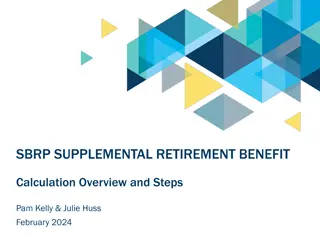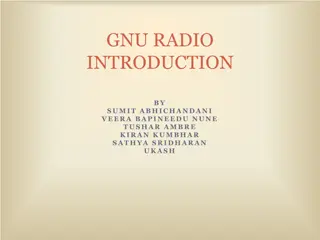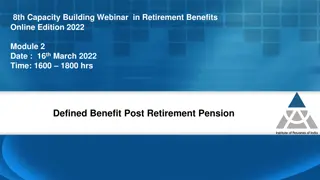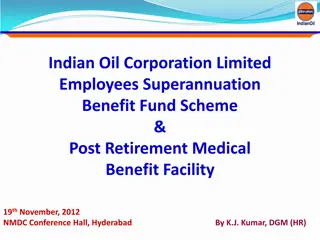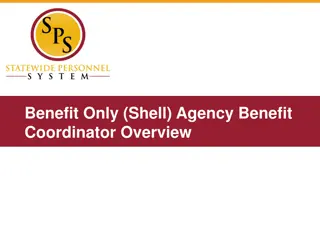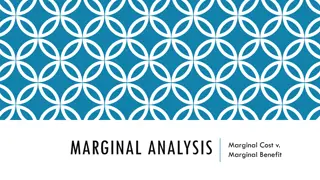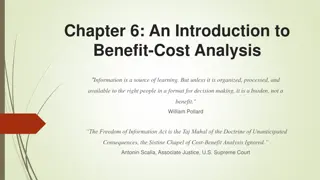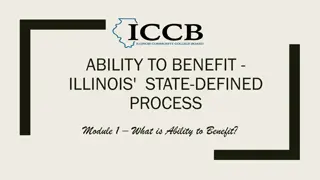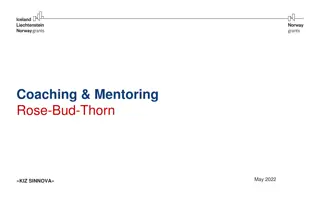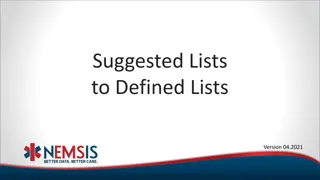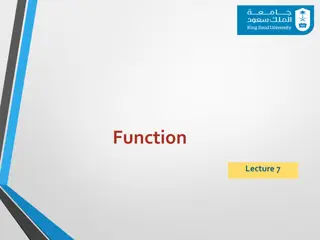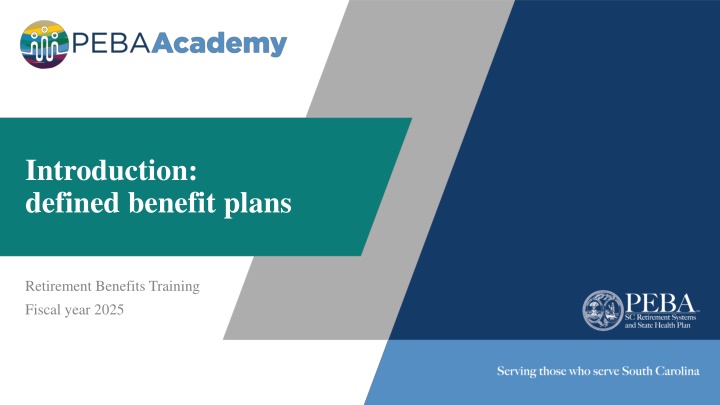
South Carolina Retirement System Defined Benefit Plans
Explore the features, eligibility, membership classes, and funding of the South Carolina Retirement System Defined Benefit Plans for employees of state agencies, public schools, higher education institutions, and more. Learn about employer contribution rates and important details for retirement benefits.
Download Presentation

Please find below an Image/Link to download the presentation.
The content on the website is provided AS IS for your information and personal use only. It may not be sold, licensed, or shared on other websites without obtaining consent from the author. If you encounter any issues during the download, it is possible that the publisher has removed the file from their server.
You are allowed to download the files provided on this website for personal or commercial use, subject to the condition that they are used lawfully. All files are the property of their respective owners.
The content on the website is provided AS IS for your information and personal use only. It may not be sold, licensed, or shared on other websites without obtaining consent from the author.
E N D
Presentation Transcript
Introduction: defined benefit plans Retirement Benefits Training Fiscal year 2025
Who can participate? South Carolina Retirement System (SCRS). Available to employees of: State agencies; Public school districts; Public higher education institutions; Participating charter schools; and Participating optional employers, such as local subdivisions of government. Police Officers Retirement System (PORS). Available to employees of participating employers who serve as: Police officers and peace officers; Firefighters; Coroners and deputy coroners; and Magistrates. Must meet eligibility requirements. Probate judges may choose SCRS or PORS. 2
SCRS, PORS membership classes Class Two Class Three Earned service began prior to July 1, 2012 Earned service began on or after July 1, 2012 Membership class affects: Service retirement eligibility; Average final compensation calculation; and Credit for unused leave at retirement. 3
Defined benefit plan features and limitations Features Limitations Lifetime monthly benefit. Refunds do not include employer contributions. Disability protection and incidental death benefit. No member control of investment decisions. Benefit permanently reduced for early retirement. Benefit adjustments (under current law). Each July 1, eligible retirees receive a 1% benefit adjustment, up to a $500 annual maximum. Benefit adjustments not connected to inflation or investment performance. Survivor benefit options available. 4
Defined benefit plan funding Investment returns critical to funding. Employers contribute a percentage of total payroll for each employee. No provisions for hardship or to borrow against account while actively employed. Employees contribute a pretax percentage of their salary. S.C. Retirement System Investment Commission pools trust funds and invests them (www.rsic.sc.gov). 5
Fiscal year 2025 employer contribution rates Effective for all wages paid on and after July 1, 2024. Incidental death benefit contribution1 Accidental death contribution1 Retirement plan Employer contribution Total Insurance surcharge1 employer rate SCRS 18.41% 0.15% N/A 18.56% 6.35% State ORP2 18.41% 0.15% N/A 18.56% 6.35% PORS 20.84% 0.20% 0.20% 21.24% 6.35% 1Rates are applicable only to employers covered under these programs. 2For State ORP participants, 5% of the employer contribution is remitted directly to the participant s State ORP service provider. 6
Employee contributions effective July 1, 2024 SCRS PORS 9% 9.75% 7
Setting contribution rates Actuary studies issues, including: Economic assumptions, such as investment return; Demographic assumptions, such as member longevity; and Actuarial methods and policies. S.C. General Assembly sets retirement system rules, including contribution rates. PEBA required to hire actuary, who: Conducts annual actuarial valuations; Completes experience study every four years; and Develops fiscal impact statements. 8
Funding period and contribution rates Funding period indicates amount of time needed to pay unfunded liability. Act 13 of 2017: Gradually reduces the maximum funding period from 30 years to 20 years by July 1, 2027; Set a schedule of employer contribution rate increases; and Increased and capped employee contribution rates. 9
Past pension reform legislation In recent years, the S.C. General Assembly passed two sets of pension legislation: Benefit reform, also known as Act 278, in 2012. Funding reform, also known as the Retirement System Funding and Administration Act of 2017. View the Past Pension Reform Legislation flyer. 10
Disclaimer This presentation does not constitute a comprehensive or binding representation of the employee benefit programs PEBA administers. The terms and conditions of the employee benefit programs PEBA administers are set out in the applicable statutes and plan documents and are subject to change. Benefits administrators and others chosen by your employer to assist you with your participation in these employee benefit programs are not agents or employees of PEBA and are not authorized to bind PEBA or make representations on behalf of PEBA. Please contact PEBA for the most current information. The language used in this presentation does not create any contractual rights or entitlements for any person. 11

